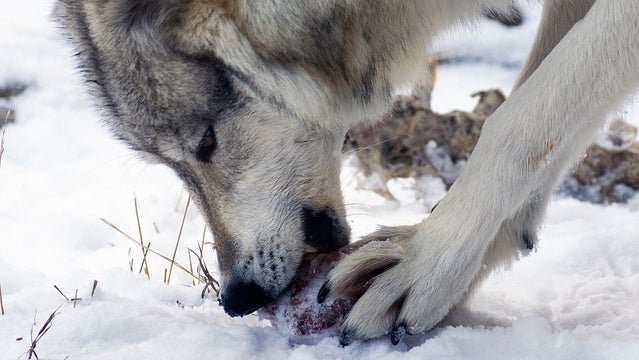After an 18-year recovery effort focused on wolf packs in the Northern Rocky Mountains and the Western Great Lakes, the U.S. Fish and Wildlife Service has determined that the gray wolf is no longer threatened with extinction. As a result, the agency has recommended under the Endangered Species Act, FWS director Dan Ashe announced today on a call with reporters.
This announcement, which has long been anticipated, is sure to cause major ripples among the conservation community. The gray wolf populations in the Northern Rockies and Western Great Lakes have already been delisted. States in those regions now administer hunting permits as part of programs designed to manage the populations at sustainable levels, and those states have faced—or are now facing—a number of lawsuits based on their wolf management plans.
If it is approved, the recommendation will expand the delisting to the federal level. It would mean that in states where populations are very small, such as Oregon and Washington, or where the gray wolf has not yet returned but could potentially thrive, such as Colorado and California, the animals would lack federal protection. Ashe was quick to point out, however, that the FWS is confident that state wildlife agencies would take appropriate steps to continue recovery efforts and manage local populations into the future.
Wyoming’s approach to managing its gray wolves has included listing them as predators that can be shot on sight in much of the state. That approach led, in part, to the death of 68 wolves in that state during the 2012 season, which state wildlife managers have reported is unsustainably high (they plan to adjust the number of permits going forward). The state’s management plan has also .
Still, Ashe said, gray wolves are “in good hands” with state wildlife management agencies. “No one in the wildlife community suggests that the gray wolf no longer requires protection,” he said. “This questions is, do they require federal protection? We believe clearly they do not. The gray wolf will remain a part of the landscape of our country for future generations.”
There are more than 6100 gray wolves in the contiguous United States, and they represent the southern reaches of a much larger population of 65,000 wolves in Canada and Alaska.
“We have no indication that states will over-harvest [gray wolves],” he added. “All the states [with delisted populations] have been professional and followed their management plans very closely. There is a lot of public interest in wolves, so I think if states were to over-harvest, I’m sure it would be brought to our attention. We would then be petitioned to re-list the gray wolf and would consider it at that time.”
Another major tenant of today’s announcement is that the FWS plans to increase its focus and resources on the recovery of the Mexican wolf in the Southwestern U.S. by designating it as an endangered subspecies.
The Mexican wolf recovery began with a very fragile population of only 7 animals, Ashe explained. “Genetically managing that kind of population is a great challenge,” he said. Plus, depravation of livestock is of greater concern with Mexican wolves, relative to gray wolves, because the former lives in regions where cattle, goat, and sheep are calving all year round. In the north, the animals calve once a year.
The proposal to federally delist gray wolves will now be open to a 90-day public comment period. The agency hopes to have a final by this time next year.


